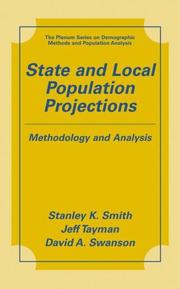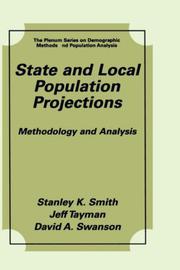| Listing 1 - 4 of 4 |
Sort by
|

ISBN: 9780306464928 0306464926 9780306473722 9786610208135 1280208139 0306473720 Year: 2001 Publisher: New York : Kluwer Academic/Plenum Publishers,
Abstract | Keywords | Export | Availability | Bookmark
 Loading...
Loading...Choose an application
- Reference Manager
- EndNote
- RefWorks (Direct export to RefWorks)
The initial plans for this book sprang from a late-afternoon conversation in a hotel bar. All three authors were attending the 1996 meeting of the Population As- ciation of America in New Orleans. While nursing drinks and expounding on a variety of topics, we began talking about our current research projects. It so happened that all three of us had been entertaining the notion of writing a book on state and local population projections. Recognizing the enormity of the project for a single author, we quickly decided to collaborate. Had we not decided to work together, it is unlikely that this book ever would have been written. The last comprehensive treatment of state and local population projections was Don Pittenger’s excellent work Projecting State and Local Populations (1976). Many changes affecting the production of population projections have occurred since that time. Technological changes have led to vast increases in computing power, new data sources, the development of GIS, and the creation of the Internet. The procedures for applying a number of projection methods have changed considerably, and several completely new methods have been developed.
Population forecasting --- Population research --- Methodology. --- Population forecasting -- Methodology. --- Population research -- Methodology. --- KBC0106-IVB --- 10.02.d --- 10.03.c --- Statistieken ; Demografische statistieken --- Actuariaat ; Constructie (Sterfte)tafels --- Social sciences. --- Public health. --- Statistics. --- Environmental management. --- Population. --- Sociology. --- Demography. --- Social Sciences. --- Population Economics. --- Sociology, general. --- Public Health. --- Environmental Management. --- Statistics, general. --- Population --- Forecasting, Population --- Population projection --- Population projections --- Projection, Population --- Projections, Population --- Methodology --- Research --- Forecasting --- Social prediction --- Historical demography --- Social sciences --- Vital statistics --- Social theory --- Human population --- Human populations --- Population growth --- Populations, Human --- Economics --- Human ecology --- Sociology --- Demography --- Malthusianism --- Environmental stewardship --- Stewardship, Environmental --- Environmental sciences --- Management --- Statistical analysis --- Statistical data --- Statistical methods --- Statistical science --- Mathematics --- Econometrics --- Community health --- Health services --- Hygiene, Public --- Hygiene, Social --- Public health services --- Public hygiene --- Social hygiene --- Health --- Human services --- Biosecurity --- Health literacy --- Medicine, Preventive --- National health services --- Sanitation --- Behavioral sciences --- Human sciences --- Sciences, Social --- Social science --- Social studies --- Civilization
Book
ISBN: 9400775504 9400775512 Year: 2013 Publisher: Dordrecht : Springer Netherlands : Imprint: Springer,
Abstract | Keywords | Export | Availability | Bookmark
 Loading...
Loading...Choose an application
- Reference Manager
- EndNote
- RefWorks (Direct export to RefWorks)
This book focuses on the methodology and analysis of state and local population projections. It describes the most commonly used data sources and application techniques for four types of projection methods: cohort-component, trend extrapolation, structural models, and microsimulation. It covers the components of population growth, sources of data, the formation of assumptions, the development of evaluation criteria, and the determinants of forecast accuracy. It considers the strengths and weaknesses of various projection methods and pays special attention to the unique problems that characterize small-area projections. The authors provide practical guidance to demographers, planners, market analysts, and others called on to construct state and local population projections. They use many examples and illustrations and present suggestions for dealing with special populations, unique circumstances, and inadequate or unreliable data. They describe techniques for controlling one set of projections to another, for interpolating between time points, for sub-dividing age groups, and for constructing projections of population-related variables (e.g., school enrollment, households). They discuss the role of judgment and the importance of the political context in which projections are made. They emphasize the “utility” of projections, or their usefulness for decision making in a world of competing demands and limited resources. This comprehensive book will provide readers with an understanding not only of the mechanics of the most commonly used population projection methods, but also of the many complex issues affecting their construction, interpretation, evaluation, and use.
Population forecasting. --- Population. --- Population forecasting --- Population research --- Demography --- Business & Economics --- Methodology --- Methodology. --- Forecasting, Population --- Population --- Population projection --- Population projections --- Projection, Population --- Projections, Population --- Forecasting --- Social sciences. --- Demography. --- Social Sciences. --- Methodology of the Social Sciences. --- Social prediction --- Social sciences --- Historical demography --- Vital statistics --- Behavioral sciences --- Human sciences --- Sciences, Social --- Social science --- Social studies --- Civilization

ISBN: 0306464934 9780306464935 Year: 2000 Publisher: New York (N.Y.) : Kluwer academic/Plenum,
Abstract | Keywords | Export | Availability | Bookmark
 Loading...
Loading...Choose an application
- Reference Manager
- EndNote
- RefWorks (Direct export to RefWorks)
Population forecasting --- Population research --- Methodology. --- Methodology --- Population forecasting - Methodology --- Population research - Methodology
Digital
ISBN: 9789400775510 Year: 2013 Publisher: Dordrecht Springer Netherlands
Abstract | Keywords | Export | Availability | Bookmark
 Loading...
Loading...Choose an application
- Reference Manager
- EndNote
- RefWorks (Direct export to RefWorks)
This book focuses on the methodology and analysis of state and local population projections. It describes the most commonly used data sources and application techniques for four types of projection methods: cohort-component, trend extrapolation, structural models, and microsimulation. It covers the components of population growth, sources of data, the formation of assumptions, the development of evaluation criteria, and the determinants of forecast accuracy. It considers the strengths and weaknesses of various projection methods and pays special attention to the unique problems that characterize small-area projections. The authors provide practical guidance to demographers, planners, market analysts, and others called on to construct state and local population projections. They use many examples and illustrations and present suggestions for dealing with special populations, unique circumstances, and inadequate or unreliable data. They describe techniques for controlling one set of projections to another, for interpolating between time points, for sub-dividing age groups, and for constructing projections of population-related variables (e.g., school enrollment, households). They discuss the role of judgment and the importance of the political context in which projections are made. They emphasize the “utility” of projections, or their usefulness for decision making in a world of competing demands and limited resources. This comprehensive book will provide readers with an understanding not only of the mechanics of the most commonly used population projection methods, but also of the many complex issues affecting their construction, interpretation, evaluation, and use.
Social sciences (general) --- Demography --- demografie --- sociale wetenschappen --- methodologieën
| Listing 1 - 4 of 4 |
Sort by
|

 Search
Search Feedback
Feedback About UniCat
About UniCat  Help
Help News
News